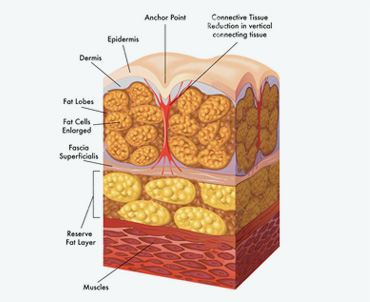
Ultrasound for cellulite
by Cellulite Institute editorial staff

Ultrasound for cellulite
Ultrasound for cellulite is a treatment proposed as one of the most effective. Cellulite is a problem that affects the vast majority of women.
Treatment can be of 2 types:
- medical treatment which combines the use of ultrasound with use of lipolytic injectable drugs, and requires a doctor;
- aesthetic treatment which consists of direct application of ultrasound on the skin, and for this there are both medical devices and beauticians, even if they are less efficient.
Ultrasound for cellulite: Anti-cellulite ultrasound in aesthetics
Of all anti-cellulite methods, it is “ultrasound for cellulite treatment” that is gaining hold in the aesthetic world.
What does it consist of in practice? The treatment is possible thanks to the aid of advanced, state-of-the-art technology: the use of ultrasound applied to aesthetic treatments. The power and frequency of ultrasound used to treat cellulite should always be calibrated for the intended purpose.
Ultrasound for cellulite: Cellulite
Cellulite is a very common problem among women. The most commonly occurring form is the accumulation of subcutaneous fat that produces the known effect of “orange peel” skin, especially on the legs, hips and buttocks. Although genetics is an important factor in this type of problem, poor lifestyle habits often contribute to making it more apparent. Exacerbating factors include:
- Smoking
- Alcohol consumption
- Stress
- Insufficient physical activity
Cellulite is not “untouchable” and it is possible to intervene in many ways to fight it.
After years of testing in aesthetics, use of the so-called “ultrasound for cellulite” is becoming increasingly popular.
Besides the name, the treatment is fairly simple: it uses ultrasound waves that have higher frequencies than human hearing (they are not perceptible to the human ear). The ultrasound waves used to treat cellulite produce about 1 million vibrations per second, penetrating deep into the tissues. Like a drainage massage applied to the deep fascia of the epidermis, the action of ultrasound:
- Enhances blood oxygenation
- Increases cellular temperature
- Stimulates cell metabolism
- Promotes capillary and lymphatic circulation
Until a few years ago, the use of ultrasound was only for medical purposes: it was often applied to relieve inflammation and muscle pain.
Today, however, it is possible to use “ultrasound for cellulite” to act deep in the adipose areas, dissolving and removing fat deposits.
Ultrasound for cellulite: how ultrasound for cellulite works
Like any type of ultrasound waves, ultrasound for cellulite requires a special device. Using the anti-cellulite device in contact with the skin, in just a few minutes of ultrasound wave exposure there is a rise in temperature and, therefore, an increase in blood flow and flow of the lymphatic fluids that causes the depressions in the skin typical of cellulite.
At the end of the treatment, it is sufficient to apply a moisturising cream on the treated area.
Ultrasound for cellulite: What is the effect of anti-cellulite ultrasound?
Ultrasound for cellulite directly affects fat by turning it into waste, which is then eliminated naturally by the body.
In anti-cellulite ultrasound treatment, the devices use a frequency of 3MHz in order to penetrate about 3 cm into subcutaneous depth.
A full treatment generally takes about 8 to 10 weeks and it is advisable to have the patients drink a lot and proceed with an activating lymphatic drainage massage in the same session.
Ultrasound for cellulite: what future for ultrasound anticellulite treatments?
Although is known that, at a biological level, cellulite is due to an abnormal increase in adipose deposits in the deepest layers of the epidermis, the factor leading to its formation is still unclear.
Often, the reason is put down to weight gain, but in reality many thin women also suffer from it.
Ultrasound for cellulite seems to be the future, insofar as it has been shown to be a more effective and safer treatment than other non-invasive treatments for cellulite.
Ultrasound for cellulite: What are the contraindications?
The contraindications are:
- Heart disease
- Pacemakers
- Liver disorders
- Epilepsy
- Thrombophlebitis
- Thrombosis
- Pregnancy
- Fever
- Skin disorders
- Auto-immune diseases
Another contraindication is that of performing the treatments too close to each other. It is better to allow time between one session and another to obtain better results.
Ultrasound for cellulite: how it works
Ultrasound can be used with ease. Where can the best results be obtained?
Here is where ultrasound is most effective:
- Localised adiposity
- Rough, orange-peel skin
- Improvements in tissue elasticity
- Reduction and elimination of cellulite nodules
- Improvement in tissue tone
- Better absorption of anti-cellulite creams
- Reactivation of local circulation
- Progressive elimination of stagnation fluids
What are the indications in aesthetics?
Ultrasound is particularly indicated in the external treatment of cellulite blemishes, in particular:
- In the remodelling of localised adiposity
- In the treatment of orange-peel and rough skin
- In improving tissue elasticity
- In improving the tissues by making them more compact and smooth
- In reactivating local circulation and skin nutrition
How many sessions are required?
The number of sessions varies from individual to individual. On average, 3 to 4 sessions a week are recommended for a cycle of at least 1 month. The protocols to be used are those that aim to improve the individual’s current situation.
At the beginning of the treatment it is recommended keep the power to a minimum and then increasing it during treatment. The instrument must always be calibrated for the single individual.
The handpiece is placed on the skin tissue and moved with slow movements in a clockwise direction.
Once the treatment has been completed, it is advisable to carry out massages or drainage sessions to help the body dispose of the fat in circulation.
Areas that can be treated with ultrasound are:
- Buttocks
- Inner and outer thighs
- Abdomen and hips
- Calves and arms
Ultrasound for cellulite: proper nutrition
It is advisable to take some precautions to maintain a good balance in order to stay healthy.
In general, it is necessary to:
- Not overdo it with smoking and alcohol
- Avoid greasy, fried foods
- Favour fruit and vegetables
- Not overdo it with sugar
- Not wear tight clothes
- Drink water during the day
- Avoid foods rich in sodium
- Perform physical activity
- Drink plenty of water
Ultrasound for cellulite: side effects
The most common side effects include:
- Damage to internal organs: this is because penetration of the ultrasound is not selective; to prevent this from occurring, it is necessary to measure the fold of adipose tissue to be treated and then calibrate the frequency for penetration.
- Burns and scalding due to the heat that is generated.
Ultrasound for cellulite: results
The main disadvantage is that the effect of ultrasound for cellulite is not lasting.
This assumes that the treatment must be repeated over time to maintain results.



